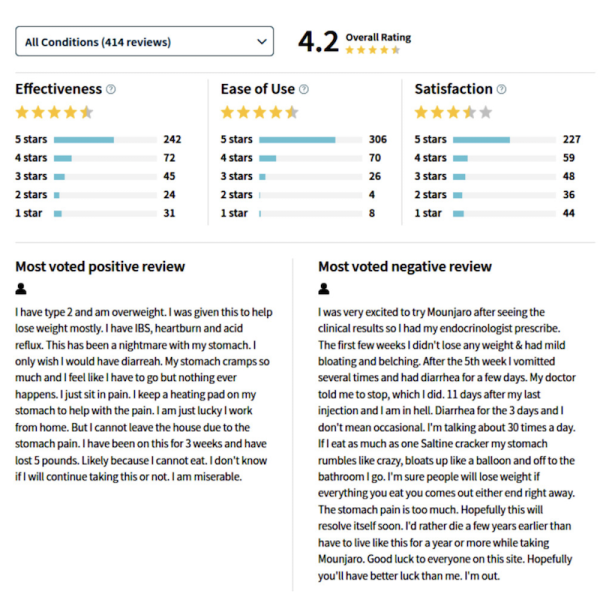Branded Content by Cosmic Press
Mounjaro is an increasingly popular name in the world of weight loss and health management. It is a medication that has been shown to have significant effects on weight loss, particularly in people who are overweight or living with obesity.
However, it’s important to be aware Mounjaro does not have FDA approval as a weight loss medication. It’s a treatment for type-2 diabetes. Nevertheless, it’s impossible to ignore its value as a weight loss drug. Many people use it in this way and report excellent results.
In the following sections, we will take a closer look at Mounjaro and how it can help with weight loss. We will also take a look at how it compares to similar weight loss drugs, the kind of results that are possible, and the potential risk and side effects of using Moujaro for weight loss.
Safer and Cheaper Alternatives to Mounjaro
Although the drug Tirzepatide is shown to help users lose body weight it is expensive, prone to some nasty side effects and not available to everyone. Here are the recommended safer alternatives that are also much more accessible and cost effective.
#1 – PhenQ -Combination Fat Burner and Appetite Suppressant

(before and after results)
CLICK to view PhenQ website for pricing and availability
PhenQ is a dietary supplement containing a blend of natural ingredients such as capsicum, caffeine, piperine, and nopal cactus fiber.
It works through multiple mechanisms to promote weight loss. PhenQ helps suppress appetite and reduce cravings through ingredients like nopal that provide a feeling of fullness.
It also helps boost thermogenic fat burning by increasing your metabolism and core body temperature. PhenQ blocks new fat production by inhibiting enzymes needed to form and store fat. Additionally, it provides an energy boost to improve physical activity. PhenQ is often billed as the best Mounjaro alternative over the counter.
Unlike prescription medications, PhenQ does not alter or simulate hormones in the body. The natural ingredients make PhenQ a potentially safer option compared to newer drugs like Mounjaro.
CLICK to view PhenQ website for pricing and availability
While effective for weight loss, Mounjaro does carry a risk of side effects like nausea, diarrhea, dizziness, and gallbladder problems. For those seeking weight loss without added hormones or harsh side effects,
PhenQ may provide similar fat burning benefits and appetite control as a non-prescription alternative to medications like Mounjaro.
#2 – Zotrim – Natura Hunger Reducer

(before and after picture)
CLICK to view Zotrim website for pricing and availability
Zotrim is an herbal weight loss supplement that contains yerba mate, guarana, and damiana as its key active ingredients.
It targets weight loss in three ways – suppressing appetite, increasing energy levels, and slowing gastric emptying.
The yerba mate and guarana provide caffeine which suppresses appetite and makes you feel more energetic and alert.
Meanwhile, damiana helps slow digestion to promote feelings of fullness and satiety after meals. Unlike synthetic weight loss drugs, Zotrim contains only plant-based ingredients that work synergistically to promote weight loss.
CLICK to view Zotrim website for pricing and availability
The natural formula makes Zotrim a potentially safer option compared to medications like Mounjaro. While Mounjaro is very effective for weight loss, it also carries risks like nausea, vomiting, diarrhea, and gallbladder disease.
Zotrim provides a natural alternative to help curb appetite, boost energy for exercise, and slow digestion without altering hormones or gastrointestinal function. For those seeking effective weight loss without the harsh side effects of prescription medications, Zotrim presents a safer herbal option to drugs like Mounjaro.
Related content:
Rybelsus Vs Ozempic – which works best for weight loss
What Is Moujaro and How Does It Work for Weight Loss?
Mounjaro is an injectable prescription medication primarily used to improve blood sugar levels in adults with type 2 diabetes. It belongs to a class of drugs known as incretin mimetics. Drugs in this class are also called glucagon-like peptide 1 (GLP-1) receptor agonists or GLP-1 analogs. Doctors normally prescribe them to patients who have not been able to control their blood sugar levels with tablet medications. [1]
One of the main Mounjaro side effects is loss of appetite. That’s why doctors often prescribe it “off-label” for weight loss.
The active substance in Mounjaro is tirzepatide. It’s a dual-action molecule that activates both GLP-1 and GIP receptors in the body. These receptors play a crucial role in managing blood sugar levels and promoting feelings of fullness after eating.
Mounjaro has been found to aid in weight loss due to its ability to mimic the effects of naturally occurring satiety hormones, GIP and GLP-1. By activating these hormones’ receptors, Mounjaro helps people feel full sooner after eating and retain the sensation for longer periods. This effect can lead to a reduction in caloric intake and ultimately weight loss.
According to a Q&A with Dr. Igel, in clinical trials, patients taking Mounjaro have reported weight loss results ranging from 10-20% of their starting body weight, or 15-30 pounds or more, over 6 to 12 months. The median time to reach at least a 5% weight loss was 16 weeks for those on a 5 mg dose of Mounjaro, and 12 weeks for those on a 10 and 15 mg dose.
However, good results will also require a commitment to a healthy diet and regular exercise.
Latest news:
Mounjaro Usage Guidelines and Dosage
To use Mounjaro for weight management, you should inject the medication under the skin, once a week. The injection can be administered at any time of day, regardless of when you last ate.
You can inject Mounjaro into your upper arm, upper thigh, or abdominal area.
The dosing schedule for Mounjaro is straightforward. The medication is provided in pre-dosed injector pens. You use the Mounjaro pen once weekly on a day that’s best for you.
It’s important to stay hydrated while taking Mounjaro. In addition to helping you to stay hydrated, drinking plenty of water can support your weight loss goals by helping to fill up your stomach.
Benefits of Choosing Mounjaro for Weight Loss
Choosing Mounjaro for weight loss can offer several benefits, particularly when used in conjunction with a healthy diet and regular exercise.
Here are some key advantages:
- Effective Weight Loss: Mounjaro has been shown to help people lose weight by decreasing food intake and slowing down the rate at which food travels through the digestive tract. In clinical trials, patients using Mounjaro reported significant weight loss results, with higher doses leading to greater weight loss [2].
- Improved Control of Diabetes Symptoms: Mounjaro was initially designed as a treatment for type 2 diabetes, and it continues to excel in this role. It aids in controlling blood glucose levels, which can be particularly beneficial for individuals who are overweight or obese and dealing with diabetes.
- Lower Risk of Heart Disease: By aiding in weight loss and improving control over diabetes symptoms, Mounjaro may indirectly contribute to a lower risk of heart disease. This is because both obesity and uncontrolled diabetes are risk factors for heart disease.
- Enhanced Confidence: The weight loss achieved through the use of Mounjaro can help boost self-esteem and confidence. Losing weight often leads to improved body image and a positive outlook, which can significantly enhance overall quality of life.
- Flexibility with Dosage: The dosage of Mounjaro can be adjusted based on individual needs and tolerance. Some people achieve significant weight loss with low doses, while others may require higher doses to see meaningful results.
However, while Mounjaro offers several benefits, it’s important to remember that potential side effects exist, particularly at higher doses.
Success Stories: Real-Life Experiences with Mounjaro

Mounjaro has been a game-changer for many people struggling with weight loss.
The WebMD website contains over 400 Mounjaro customer reviews. Some of them are from people using the drug to manage type 2 diabetes, others are from people using Mounjaro to lose weight.
However, although the medication has an overall rating of 4.2 stars out of 5 and many users report good results, a minority of Mounjaro users say they experienced no benefits at all. There are also a lot of reports of side effects.
One user, who detailed her experience with the drug on The Cut (lifestyle magazine) said it helped her to lose weight while maintaining her body positivity. Despite initial reservations about using a weight-loss drug, she found that Mounjaro upended her previous struggles to lose weight.
A user on Hemophilia News Today also shared a favorable experience, describing Mounjaro as a “life-changing medication” that transformed her relationship with food overnight. She said she rarely felt hungry and noticed a significant reduction in cravings.
Although these stories underscore the potential of Mounjaro as a tool to aid weight loss, it’s important to remember that individual experiences may vary and reports of side effects are common. Even some people who were losing weight with the medication have been forced to stop using it because it was making them feel ill.
Mounjaro Side Effects
Although Mounjaro can be a beneficial tool for weight loss and managing type 2 diabetes, it does come with potential side effects and risks potential users need to consider.
Common side effects of Mounjaro include:
- Nausea and Vomiting: These are among the most reported side effects of Mounjaro. They are usually mild to moderate and tend to decrease over time as your body adjusts to the medication.
- Diarrhea: This is another common side effect. It is typically mild and tends to resolve over time.
- Injection Site Reactions: Some people may experience redness, swelling, or irritation at the site of the Mounjaro injection.
In some cases, the gastrointestinal side effects are severe enough to cause people to stop using Moujaro and seek alternative options instead.
Additional Risks and Dangers of Mounjaro
In addition to unpleasant side effects, Mounjaro also has the potential to induce more serious health risks:
- Hypoglycemia: If people use Mounjaro alongside other drugs that reduce blood sugar, such as insulin, it may cause hypoglycemia – a condition that involves dangerously low blood glucose levels.
- Kidney Problems: Mounjaro can cause new or worsen existing kidney problems.
- Pancreatitis: In rare cases, Mounjaro may cause pancreatitis (inflammation of the pancreas). Initial symptoms include severe stomach pain that will not go away, vomiting, or feeling unwell. If the condition persists, it can cause life-threatening complications such as organ failure.
- Allergic Reactions: Like all medications, Mounjaro can cause allergic reactions in some people. Symptoms can include swelling of your face, lips, tongue, or throat, trouble breathing, or skin rash.
- Thyroid Cancer: GLP-1 receptor agonists may have the potential to cause thyroid cancer. According to research published in Diabetes Care, the risks increase after 1-3 years of treatment. [3]
It’s important to discuss these potential side effects and risks with your healthcare provider before starting Mounjaro. They can provide personalized advice based on your health history and current medications.
How Mounjaro Compares to Alternative Weight Loss Injections
Mounjaro is not the only weight loss injection available on the market. Several alternatives exist, each with its own set of benefits and drawbacks. Two of the most notable alternatives are Semaglutide (marketed under the brands Ozempic and Wegovy) and Liraglutide (Saxenda).
Mounjaro Compared to Ozempic/Wegovy
Ozempic is a long-acting form of semaglutide. Like tirzepatide, semaglutide is a glucagon-like peptide-1 (GLP-1) receptor agonist that has FDA approval as an anti-diabetic medication and has become a popular off-label option for weight loss.
Wegovy also provides semaglutide but the dose is slightly higher. Although it has Food and Drug Administration approval as a weight loss injection, the only difference between Wegovy and Ozempic is its strength.
Semaglutide and Mounjaro (tirzepatide) are very similar drugs. Both options mimic the effects of GLP-1, which regulates blood glucose levels and appetite.
However, there are some key differences between the Mounjaro and Ozempic/Wegovy.
- Effectiveness: The results of a comparison study suggest Mounjaro’s ability to control blood sugar levels is superior to semaglutide. [4]
- Mechanism of Action: While both medications mimic the effects of GLP-1, Mounjaro is known as a dual incretin or a “twincretin” because it combines the actions of GLP-1 and GIP, another hormone that plays a role in controlling blood sugar. Semaglutide, on the other hand, only mimics the effects of GLP-1.
- Side Effects: Both drugs present similar side effects and risks. However, individual experiences with side effects can vary.
- Branding and Indications: Semaglutide is available under the names Ozempic and Rybelsus for diabetes and Wegovy for weight loss. Mounjaro is a newer medication and does not have different brand names for different indications].
In conclusion, while both semaglutide and Mounjaro have proven effective for managing type 2 diabetes and promoting weight loss, they differ slightly in their mechanisms of action and effectiveness.
How Mounjaro Compares to Saxenda
Mounjaro and Saxenda are both injectable medications used for weight management and to improve glycemic control in adults with type 2 diabetes mellitus. However, there are differences in their mechanisms of action, dosing frequency, ratings, and possible side effects.
- Effectiveness Both drugs seem to offer similar benefits to type 2 diabetics and people seeking weight loss.
- Mechanism of Action: Saxenda is a glucagon-like peptide 1 receptor agonist (GLP-1 agonist), while Mounjaro is a dual agonist, impacting both GLP-1 and GIP. This means that they work slightly differently in the body, though both aim to regulate blood sugar levels and reduce appetite.
- Dosing Frequency: Mounjaro differs from Saxenda in that it is a once-weekly injection, as opposed to Saxenda which is administered daily.
- Side Effects: The Saxenda side effects and risks are similar to those of Mounjaro. Reports of gastrointestinal issues are common and both drugs are distributed with boxed warnings that highlight the risks of pancreatitis and thyroid cancer.
The bottom line is both Mounjaro and Saxenda can be effective for weight management and improving glycemic control in adults with type 2 diabetes. The choice between the two may depend on your personal medical history, lifestyle, and preference for dosing frequency.
Mounjaro Weight Loss FAQs
Here are some questions and answers that are regularly asked about the drug.
What is Mounjaro’s role in body weight reduction?
Mounjaro works by mimicking the action of the glucose-dependent insulinotropic polypeptide (GIP). By doing so, it helps reduce body weight by decreasing appetite and increasing feelings of fullness after meals.
What are the average weight reductions with Mounjaro?
In clinical trials, study participants experienced significant weight loss, with some participants losing up to 15% of their initial body mass index (BMI).
Can people with chronic kidney disease use Mounjaro?
Mounjaro should be used with caution in patients with severe renal impairment or end-stage renal disease because it may increase the risk of volume depletion.
What are the potential serious allergic reactions to Mounjaro?
Though rare, serious allergic reactions to Mounjaro can occur, including symptoms such as hives, difficulty breathing, and swelling of the face, lips, tongue, or throat.
Does Mounjaro cause thyroid tumors?
Animal studies suggest Mounjaro may increase the risk of thyroid tumors. However, scientists are still trying to ascertain the dangers the medication may present to humans.
What is the safety profile of Mounjaro?
Mounjaro has a well-established safety profile. The most common side effects are gastrointestinal-related, including decreased appetite and abdominal pain. However, the medication is still relatively new and more side effects and risks may become apparent over time.
Who can use Mounjaro for weight loss?
Mounjaro may be available to adults who are obese or overweight. However, adults who are borderline obese need to have at least one weight-related condition, such as high blood pressure, type 2 diabetes, or high cholesterol.
How do you use Mounjaro for losing weight?
Mounjaro is an injectable medication. You take it weekly, placing the needle just under the skin. The healthcare provider who prescribes Mounjaro will determine the dosage.
Are there any dietary restrictions while using this medication?
There aren’t specific dietary restrictions while using Mounjaro. However, it’s important to use Mounjaro with a healthy diet and regular physical activity.
Can I use Mounjaro if I’m pregnant or breastfeeding?
As with similar medications, it’s unwise to use Mounjaro during pregnancy or while breastfeeding unless the potential benefits outweigh the potential risks.
Can I drink alcohol while using weight loss shots?
Although there are no specific warnings against drinking alcohol while taking medications such as Mounjaro, alcohol can affect blood sugar levels, potentially increasing the risk of hypoglycemia (low blood sugar).
Final Thoughts: Is Mounjaro Right for You?
Deciding to use Mounjaro for weight loss is a personal decision that should be made in consultation with a healthcare professional.
This medication has been shown to be effective in managing blood sugar levels and promoting weight loss. However, it’s essential to consider the potential side effects and risks associated with its use, including hypoglycemia, kidney problems, pancreatitis, allergic reactions, and potentially thyroid cancer.
These risks might be acceptable to some people based on their current health situation and weight loss goals, but not for others. For those considering Mounjaro, it’s advisable to thoroughly discuss these factors with your doctor to make an informed decision.
It’s also important to understand that medications like Mounjaro should be used alongside lifestyle changes, such as diet and exercise. A healthy lifestyle is essential for long-term weight management. However, it’s important to consider the risks and side effects. Speak with your healthcare provider to determine if Mounjaro is right for you.
Mounjaro (Tirzepatide) Trusted Sources and Clinical Study 2023
- FDA Approves Novel, Dual-Targeted Treatment for Type 2 Diabetes: https://www.fda.gov/news-events/press-announcements/fda-approves-novel-dual-targeted-treatment-type-2-diabetes
- Tirzepatide Once Weekly for the Treatment of Obesity: https://pubmed.ncbi.nlm.nih.gov/35658024/
- GLP-1 Receptor Agonists and the Risk of Thyroid Cancer: https://diabetesjournals.org/care/article-abstract/46/2/384/147888/GLP-1-Receptor-Agonists-and-the-Risk-of-Thyroid?redirectedFrom=fulltext
- Tirzepatide versus Semaglutide Once Weekly in Patients with Type 2 Diabetes: https://www.nejm.org/doi/full/10.1056/NEJMoa2107519
Branded content furnished by our promotional partners. The Daily Sundial editorial staff is not involved in its production. Content does not reflect the views or opinions of the editorial staff.






